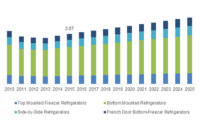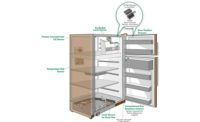Once you've finished the article, watch the editorial video "Refrigeration Trends"!
Refrigerators seem to be one of the least complicated appliances, found in nearly every home. You plug them in, and they keep food and drinks cold. However, the inner workings of the refrigerator have become increasingly sophisticated, and are consistently being improved upon to boost energy efficiency and reduce environmental impact in both the manufacture and the use phase of the appliance.
Polyurethanes are the insulation used inside today’s refrigerators and freezers, and are critical components of other appliances consumers use every day, including water heaters. “Today, polyurethanes are used in virtually all of the refrigerators manufactured around the world,” said Michael J. Krupa, technical service manager - BASF Polyurethanes.
Unlike many appliances, which exist purely for convenience or entertainment, refrigerators are truly critical. Approximately 50 percent of the world’s food would rot without insulated refrigeration*. Growing urban populations require massive investment in the storage, transportation and processing of perishable foods under controlled temperature conditions.
History of Refrigerator Insulation
The first refrigerators had no insulation, and depended on cool climates, basements and ice blocks to remain cool. Next-generation refrigerator models used fiberglass insulation, which was subject to failure. Water would leak onto the freezer compartment or condense on it and freeze, producing a thermal bridge.
Fiberglass units, while no longer manufactured, can still be found in some homes. They can be identified by feeling the top exterior surface. The lack of insulation around wiring and tubing that pass into the freezer compartment results in a cold spot on the top. Another simple test for fiberglass insulation is to open the door of the unit and using both hands, press together from the outside and inside at the same time. If there is fiberglass insulation, the wall will flex, because fiberglass provides little lateral structural strength**. Polyurethane insulation addresses these issues.
Polyurethanes became widely used as refrigerator insulation in the mid-1980s. Fully integrating rigid foam insulation into refrigerator construction resulted in a more efficient unit.
“Manufacturers immediately moved to polyurethanes for several reasons,” said Ed Ball, manager of polyurethanes application development, insulation, for Bayer MaterialScience. “Reduced energy consumption was a primary driver, and the increased efficiency of polyurethane insulation allowed manufacturers to thin the walls of the units, giving consumers more interior space with no increase in exterior volume.”
Due to their thermal, processing and hygienic advantages, polyurethanes and polyisocyanurates are by far the most widely used insulating materials for refrigeration. They’ve also helped manufacturers meet and exceed energy consumption regulations put into place by the U.S. Department of Energy.
Energy Efficiency
As refrigerators became able to reliably keep items inside cool, manufacturers’ attention shifted to their energy efficiency, driven in large part by increasingly stringent governmental regulations.
Krupa added, “Insulation provides the biggest component to achieving Energy Star ratings. The bar is set higher and higher for energy efficiency and performance. Chemical manufacturers are constantly working to produce better insulating foams with the foaming agents available, while meeting regulations set around global warming and ozone depletion.”
Environmental regulations also encourage partnerships between refrigerator manufacturers and polyurethane manufacturers. By marrying their technologies to engineer changes to the fridge and chemistry changes to the insulation, refrigerators continue to exceed energy ratings.
How it Works
Rigid polyurethane foam is an essential and cost-effective material for meeting required energy ratings in consumer refrigerators and freezers. The thermal insulating properties of rigid polyurethane foams result from the combination of a fine, closed-cell foam structure and cell gases that resist heat transfer.
Modern refrigerators and freezers consist of a sheet metal outer casing and an inner liner made of polystyrene. In between these is a layer of rigid polyurethane foam that acts as both a structural and an insulating material that is applied and cured in appliance manufacturers’ assembly line.
During their manufacture, the polyurethane material is injected between the steel outer case and inner plastic liner. It is injected as a liquid, and over a short period of time (around 30 seconds), expands over 30 times its volume to fill the space between liner and outer case. The same process is used to insulate doors. The polymer foams right inside the refrigerator walls, and fills every nook and cranny, making it extremely airtight.
The adhesive properties of polyurethanes ensure a firm bond between the inner and outer walls, and also help prevent heat exchange between the interior and exterior. Polyurethane insulation also provides structure, in addition to insulating. The mechanical strength of these foams is remarkable because high compressive and shear strengths allow low-density insulating cores to be faced with relatively thin steel or aluminum, yet span long distances unsupported. The foam can hold together many of the components in a refrigerator or hot water heater and help carry the loads of the cabinet and contents, while it continues to perform as thermal insulation. This unique combination of properties allows rigid polyurethane foams to be used in many diverse applications.
Research & Development
As polyurethane manufacturers work to improve the insulating properties of polyurethane foam, they also focus on reducing potential environmental impacts. For example, using next generation compounds to “blow” the foam can help avoid ozone depletion.
Ball added, “Research and development investments at the manufacturer level are designed to deliver improved consumer benefits and reduce energy consumption without impacting the environment. We work diligently to balance insulation efficiency with current and future Energy Star criteria.”
Notes
* Polyurethanes.org, 2013, Web. www.polyurethanes.org/index.php?page=refrigeration-and-freezers
** Evaluating Alternative Simple Rules For Choosing Refrigerators to Replace. James Cavallo, Ph.D., Kouba-Cavallo Associates and Home Energy Magazine, James Mapp, Ph.D., Wisconsin Division of Energy, 2002, Web.


